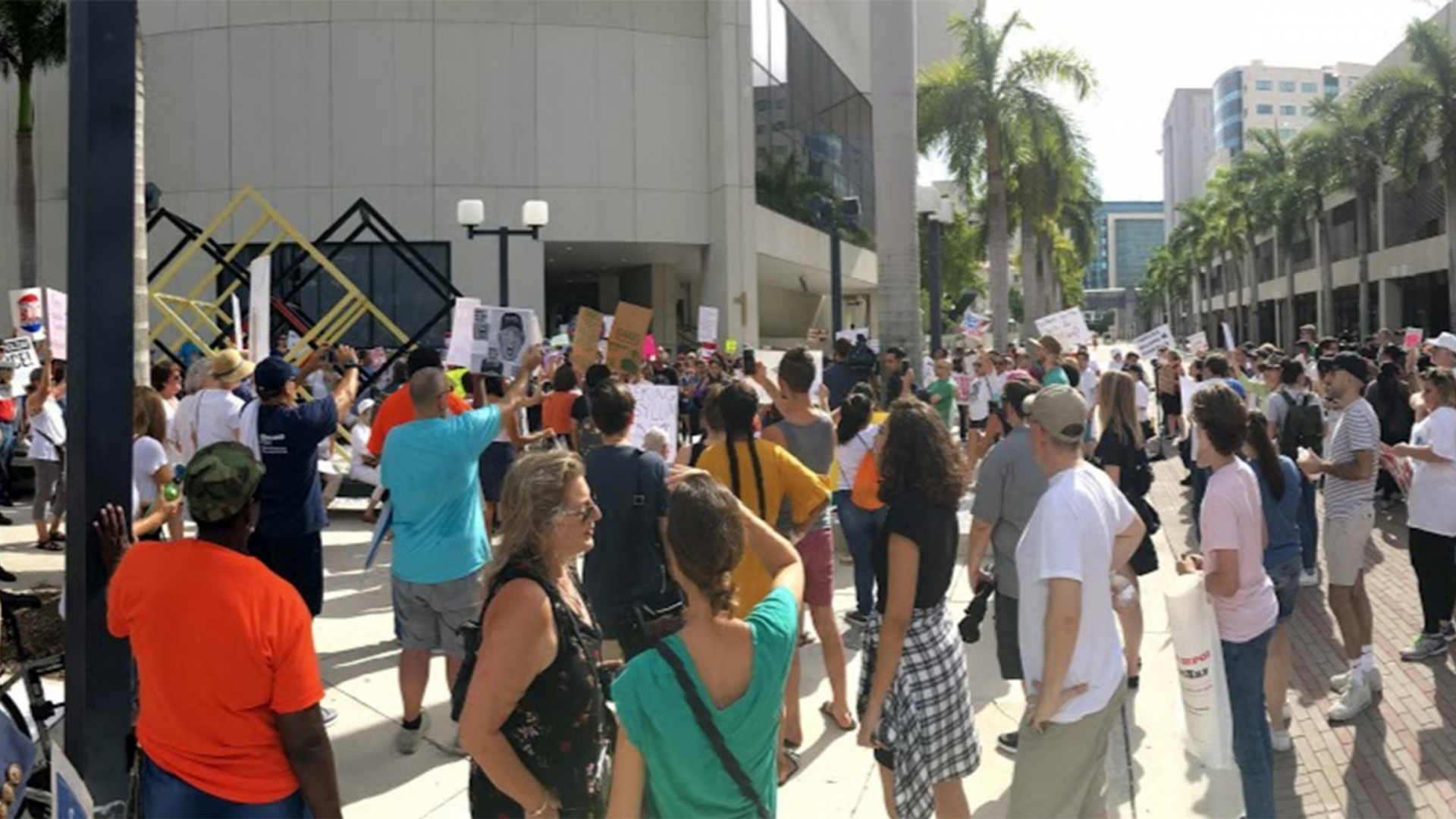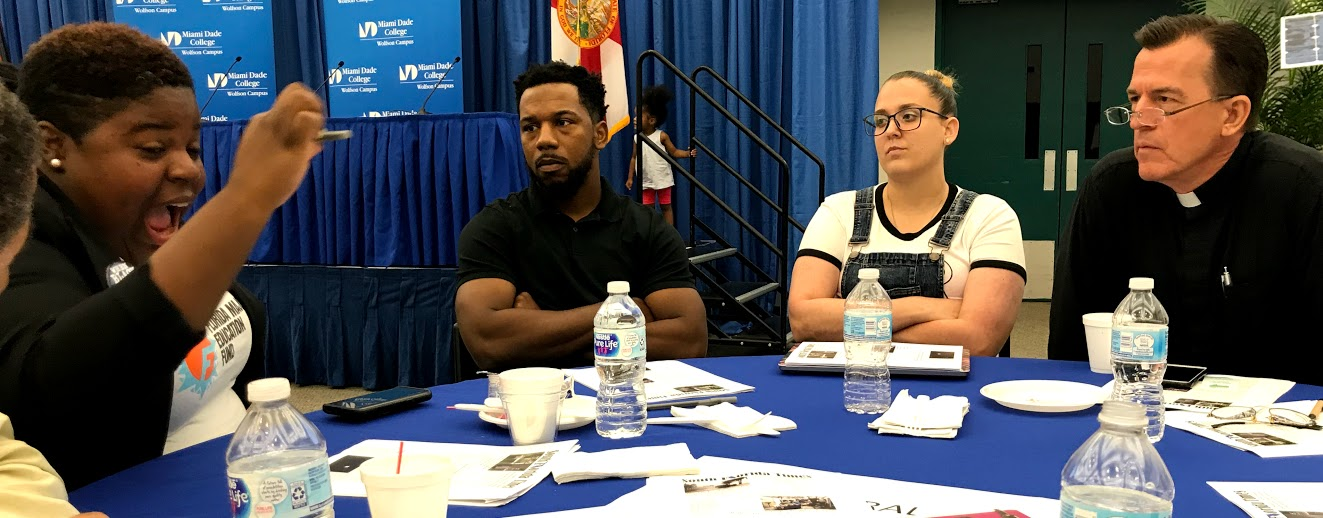Written by Thaddeus Pawlowski

On Saturday, June 30, about 200 people representing a coalition of community groups from 14 different neighborhoods gathered at Miami Dade College to create neighborhood-based disaster action plans. The session opened with Valencia Gunder of the New Florida Majority, who situated the day’s activities within a larger struggle for social justice for historically disenfranchised communities.
Participants gathered at tables by neighborhood as a facilitator walked them through a sequence of events leading up to and through the aftermath of a Category 5 hurricane in South Florida. The event organizer Michael McDonald delivered the scenario through a series of front pages of the South Florida Times starting in April 2019, that were dropped on the tables every 10 minutes. First, an explosion at Turkey Creek Nuclear Plant, then scientists warning of rapid ice melt in Antarctica, next 40 cases of Zika were reported in the region... At each new turn the facilitator asked, “How would you deal with this? How would you help your neighbors deal with this?”
In June, an approaching hurricane triggers a mass evacuation north. Millions are trapped in traffic on 1-95. When the hurricane veers off course and hits the Gulf Coast instead, it becomes clear that those who stayed behind may have been better off. Now South Florida may be asked to house evacuees from the western part of the state. Do the services and infrastructure to support them exist? Probably not, with power disruptions, infectious disease outbreaks, civil unrest, and total disruption of the economy. How do we deal with this?

Participants used their own experiences in Hurricane Irma as a starting point; the prompts helped spur a critical conversation about what they—and especially the government—could have done better. One of the same themes recurred throughout the scenario: A lack of reliable public information and a lack of trust between the government and communities, particularly the large immigrant communities in places like Little Haiti that are now under threat from sporadic ICE raids and deportation, and also from communities that have had historic tension with police. There was also frequent mention of an antagonistic relationship between the utility providers and the people they serve. Florida Power & Light Company (FPNL) was accused of charging customers for power when their lights were out and for being arbitrary or perhaps discriminatory in the planned interruption of service and scheduling of repairs. There was much talk about the 2020 franchise agreement that could break this monopoly, or at least reset the terms to make FPNL be more responsive to their customers.
If FPNL became the focal point for failed responsiveness, the blame for the proliferation of poor information could be spread in many directions. This is a region a geographer might mistake for one city of six million people; South Florida is a conglomeration of three counties with nearly 100 separate municipalities and many people living in unincorporated areas. Phillip Stoddard, mayor of South Miami (pop. 12,000), was one of the only government officials to attend the full-day event. During Hurricane Irma he made his own evacuation map that he pushed out to his constituent email list, which he had compiled himself. South Miami is inland and therefore not in the county’s evacuation zone. But NOAA released a storm surge projection that put the parts of the city along the transverse glades into the surge zone. The mayor, who is also a professor of biology at the University of Miami who does fascinating experiments with mosquitoes, overlaid this surge grid with his own elevation and street map to push a more accurate surge projection to his constituents.
Another theme was misplaced public priorities—as one young man put it, “The whole narrative needs to be changed.” He pointed out that one of the scenario’s news headlines talked about storm damage in relation only to damage to property. “Why don’t they talk about how it affects people’s lives? What do we care about some box that some nameless millionaire owns?”
After lunch, the participants self-organized by topic, which nearly mirrored but expanded on FEMA’s Emergency Support Functions: shelter, communications, transportation, logistics, extreme heat, participatory budgeting. At the tables, the conversation focused first on the major issues in each sector and then on solutions. The striking thing about the solutions was not their novelty but how many were repeated across sectors. Resilience hubs that could be sources of public information, provide backup solar power during outages, and connect people to resources and support during times of need; better engagement with the community to devise household preparedness plans; and more incentives for businesses to help workers weather extreme events.
The day closed with a presentation of these solutions to a panel that included ane Gilbert, Chief Resilience Officer for the City of Miami; the Emergency Management Director from Miami-Dade County; the head of disaster response for the Red Cross; and Commissioner Daniella Levine Cava, who recently wrote a post-Irma action report which echoed many of the points made.
Notably absent from the days’ conversation were perspectives on actions for a more resilient long term future. Emergency response is critical and many people rightly pointed out that neighbors are always the first responders and so should be better prepared for the shocks ahead. But could the community building evidenced here be translated into city building? Could this coalition help to guide the fundamental questions about what kind of place South Florida will be in the next 30 or 50 years? The conversation halted at these existential questions: Can we support more people? Can we change this narrative?
These questions are not abstract but are the most pressing. On the same day as the workshop, FEMA was ending the hotel program for Puerto Ricans displaced by Hurricane Maria, which immediately resulted in as many as 900 homeless families in South and Central Florida. They literally have nowhere to go and will soon be thrust upon dwindling public services, making them likely to fall into an expanding permanent underclass for whom stable housing and employment are becoming more out of reach. This crisis is an early indicator of the displacement and disruption that can be expected with increasing sea levels and more frequent and deadly storms. Radical action is not just needed—it is inevitable. The question is what values will guide the tough decisions ahead. Will those values be democratic, urging us to do the best for the most, and especially the most vulnerable; or will they be reactive, helping those that have much hold on to what they have?
At the end of the day, we walked out of the conference room to be greeted by hundreds of Floridians marching to protest President Trump’s immigration policies. Perhaps there need to be more marches, not just for the injustices we confront today, but those catastrophic injustices looming in the not too distant future.